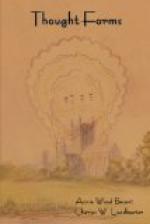[Illustration: FIG. 48. HELPFUL THOUGHTS]
[Illustration: FIG. 49. HELPFUL THOUGHTS]
[Illustration: FIG. 50. HELPFUL THOUGHTS]
[Illustration: FIG. 51. HELPFUL THOUGHTS]
[Illustration: FIG. 52. HELPFUL THOUGHTS]
[Illustration: FIG. 53. HELPFUL THOUGHTS]
[Illustration: FIG. 54. HELPFUL THOUGHTS]
FORMS BUILT BY MUSIC
Before closing this little treatise it will perhaps be of interest to our readers to give a few examples of another type of forms unknown to those who are confined to the physical senses as their means of obtaining information. Many people are aware that sound is always associated with colour—that when, for example, a musical note is sounded, a flash of colour corresponding to it may be seen by those whose finer senses are already to some extent developed. It seems not to be so generally known that sound produces form as well as colour, and that every piece of music leaves behind it an impression of this nature, which persists for some considerable time, and is clearly visible and intelligible to those who have eyes to see. Such a shape is perhaps not technically a thought-form—unless indeed we take it, as we well may, as the result of the thought of the composer expressed by means of the skill of the musician through his instrument.
Some such forms are very striking and impressive, and naturally their variety is infinite. Each class of music has its own type of form, and the style of the composer shows as clearly in the form which his music builds as a man’s character shows in his handwriting. Other possibilities of variation are introduced by the kind of instrument upon which the music is performed, and also by the merits of the player. The same piece of music if accurately played will always build the same form, but that form will be enormously larger when it is played upon a church organ or by a military band than when it is performed upon a piano, and not only the size but also the texture of the resultant form will be very different. There will also be a similar difference in texture between the result of a piece of music played upon a violin and the same piece executed upon the flute. Again, the excellence of the performance has its effect, and there is a wonderful difference between the radiant beauty of the form produced by the work of a true artist, perfect alike in expression and execution, and the comparatively dull and undistinguished-looking one which represents the effort of the wooden and mechanical player. Anything like inaccuracy in rendering naturally leaves a corresponding defect in the form, so that the exact character of the performance shows itself just as clearly to the clairvoyant spectator as it does to the auditor.




